QUIET BIRDMEN AND DISTINGUISHED INTERSECT…
As a pilot, who is a member of the Quiet Birdmen, and a Distinguished Rifleman I am aware that Camp Perry was once used as an Army Airfield during the interwar years. What I only recently discovered was that it was also the site of an unusual shooting contest that paired my two favorite hobbies, aviation and competitive shooting.
The 1925 National Matches were scheduled for Camp Perry from August 22nd through September 30th with the National Rifle Team Match, for the Dogs of War Trophy, the premier event.
The Program noted that the match would be open to ten man teams representing the National Guard and civilian teams from the several states and territories, various Organized Reserve, Citizen’s Military Training Camps, Reserve Officer Training Corps, the US Military and Naval Academies, and some miscellaneous organizations.
On the active duty side of the house the Marines and Navy fielded one team each. The Army had teams representing the Infantry, Cavalry, Coast Artillery, and Engineers. The fact that the Army could field four teams, and sometimes more, if the Signal, Field Artillery, Quartermaster, and Chemical Corps had enough skilled riflemen was a very sore point with the two seagoing services who felt, with some justification, that the situation stacked the deck in favor of the Army. It wouldn’t be until the National Matches resumed after World War II that the services would achieve parity: one service, one team.
While the Army enjoyed an overwhelming advantage over its rivals one of its components, the Army Air Service, was conspicuously absent. It would seem odd because there was a long tradition, well long for an organization that was only 18 years old, of shooting dating back to August 20, 1910. On that day, a Curtiss A-1 pusher, piloted by its manufacturer Quiet Birdmen Glenn Curtiss, cruised in lazy circles above Brooklyn’s Sheepshead Bay Race Track. Sitting to Curtiss’ left was Second Lieutenant Jacob E. Fickle. Squinting through the sights of a 1903 Springfield rifle, he squeezed the trigger, worked the bolt, and squeezed the trigger again, blowing two 30 caliber holes in a three by five-foot target on the ground 100 feet below him. With those two shots Fickle entered the annals of aviation as the first aerial gunner.
Fifteen years later the Air Service was a more technically mature organization. If the Army wouldn’t let the Air Service participate at Camp Perry it was prepared to participate in the National Matches on its own terms. While sixty-six team were shooting in the National Rifle Team Match five aircraft were squadded for what was promoted as “The World’s First Competitive Aerial Shooting Match,” although some Great War aviators might have taken some umbrage at the grandiose billing.
Rather than the more mundane National Match course of fire the spectators would observe something even more exciting, “… actual fire from the planes in the air… directed against ground objects, silhouette targets, and moving objects.”
On the 25th of August 1925 five aircraft darted in the airspace above Camp Perry with both pilot and observer required to shoot at targets staked out on the Camp Perry greensward. One, a DH-4 from the 321st Observation Squadron based at Pearson Field, Vancouver Barracks, Washington, was fitted with four 30 caliber Browning machine guns, two fixed on the right side of the fuselage, synchronized to fire forward through the propeller arc, with 1,000 rounds of ammunition, and two on a Scarff ring with 970 rounds of ammunition for the observer in the rear to wield. First Lieutenant Oakley Kelly, Air Service Reserve was at the controls while Sergeant William Steckel manned the flexible machine gun in the aft cockpit.
Oakley, now an obscure aviation footnote, was one of the most famous pilots of the pre-Lindbergh era, He had teamed up with Lieutenant John A. Macready, another Quiet Birdmen, for two record setting flights. The pair set a 35 hour, 18-minute world endurance record on Oct. 6, 1922. The following year a 26 hour, 50 minute, and 38 second trip from Roosevelt Field, New York, to Rockwell Field, California, was the first non-stop transcontinental flight.
By performing "the most meritorious flight of the year" they were presented with the prestigious Mackay Trophy for an unprecedented two consecutive years. Only one other person has received two Mackay’s and that was Hap Arnold, the first winner, and his were 23 years apart. It also was Macready’s third, a mark untouched in aviation history.
Streaking toward the ground Oakley pointed his ‘plane at the standing target and loosed a stream of bullets from the fixed guns. The bullets kicked up clumps of grass and dirt and, after the dust had settled, the scorers counted his bullet holes and awarded him a score of 270 points out of a possible 300. On a second pass Steckel stood up in the rear cockpit as Oakley guided the aircraft so he could direct fire at a recumbent target, posting a score of 250 out of 500. With a score of 520 they outshot the nearest competition by 58 points to win the one and only Camp Perry Competitive Aerial Shooting Match.
They lucked out in more ways than just winning the match. Two fellow aviators, and contestants, were disqualified when they wrecked their plane.
As mentioned earlier I am a Quiet Birdman and so, it turns out, was Oakley. We were both in the Army when we shot at Camp Perry. But that is not an uncommon occurrence. What is uncommon, and joins me to Oakley, is the fact that 61 years after his win I won a match at Camp Perry, likely making us the only two Quiet Birdmen to ever win a shooting match at the National Championships.






